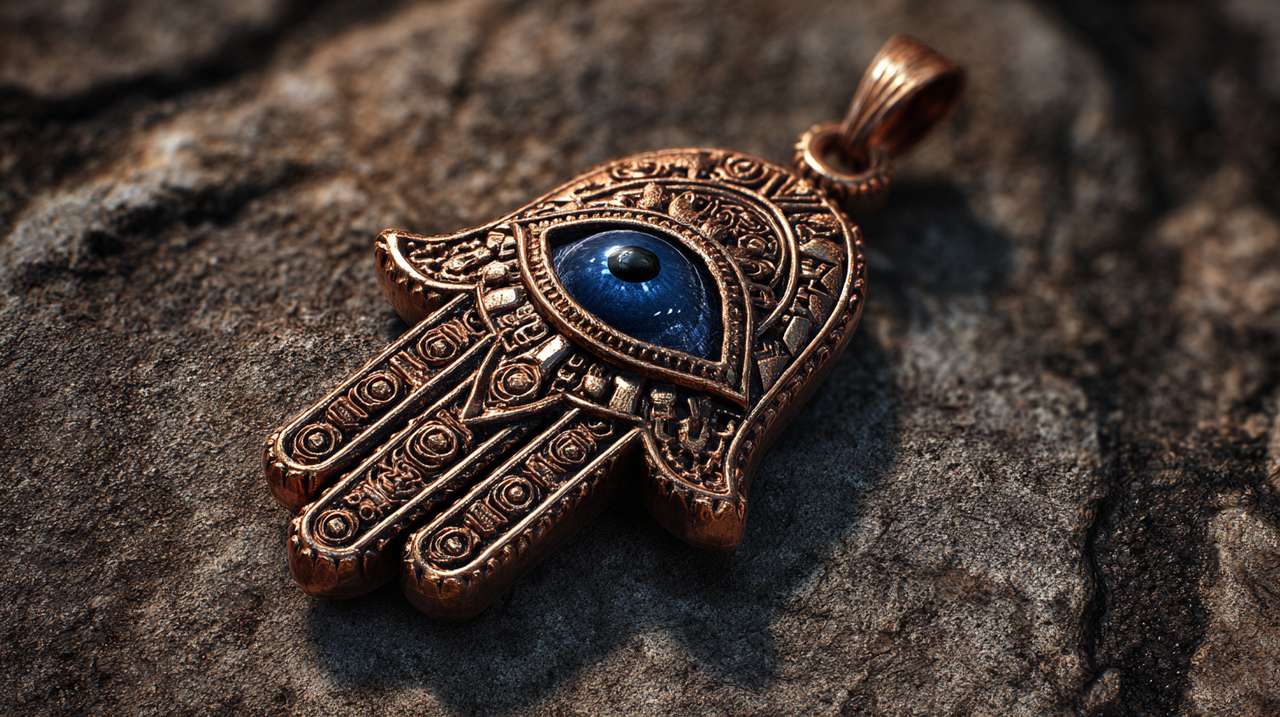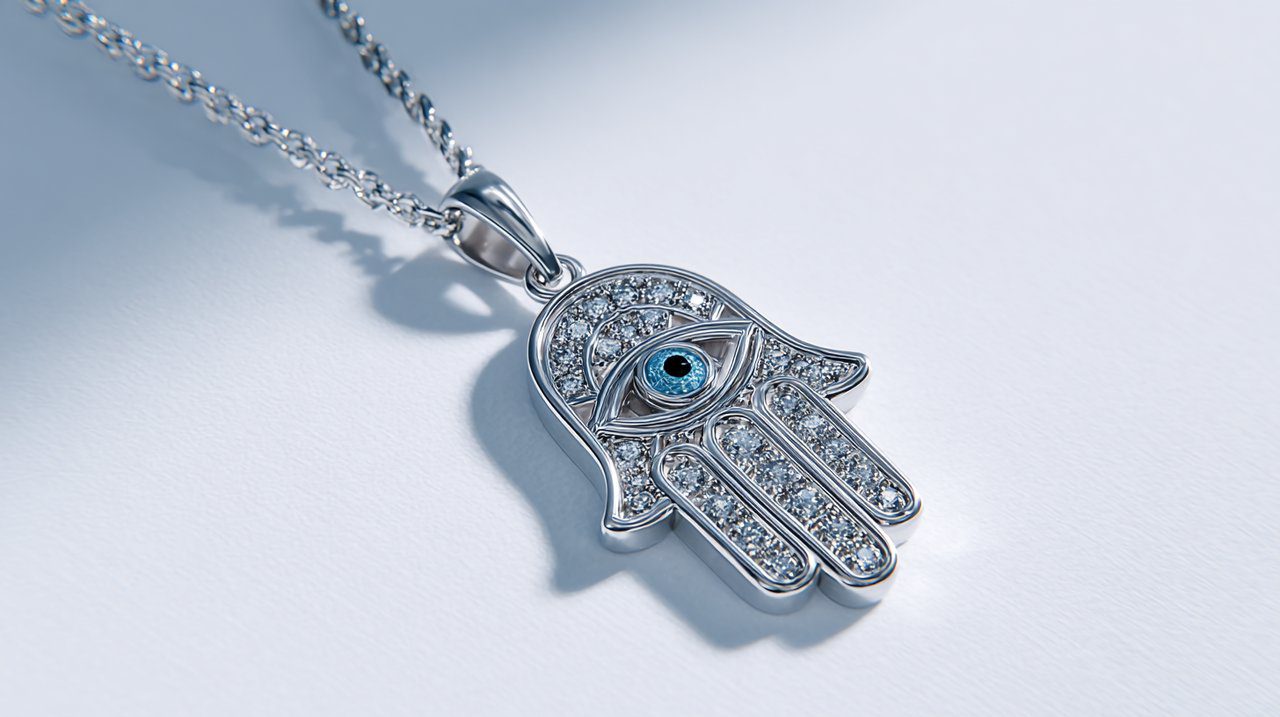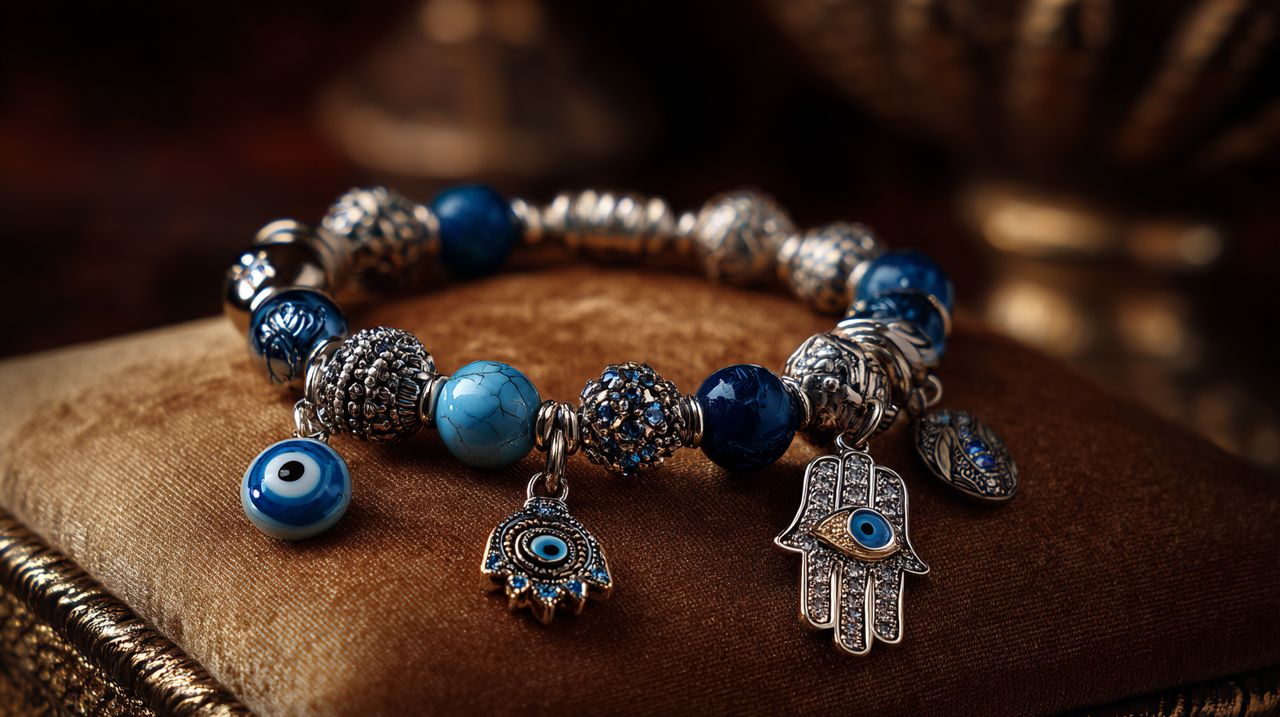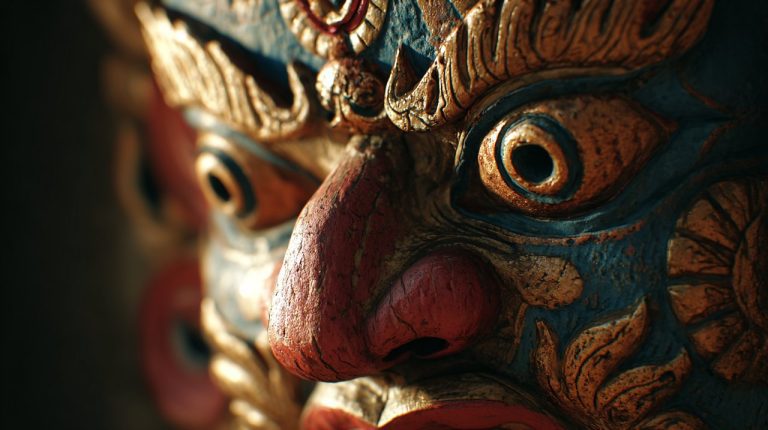The Hand and the Gaze: Unraveling the Mystical Meanings of Hamsa and Evil Eye
Humanity has long sought protection from unseen threats and subtle energies. This innate desire for safety drives the creation of powerful protective symbols and talismans.
Each amulet, each crafted piece, embodies the hopes, fears, and wisdom of generations. Among these, the Hamsa Hand and the Evil Eye are iconic symbols, revered globally for their protective qualities and ability to shield one’s energy.

The Enduring Power of Protective Symbols
How do ancient symbols continue to resonate so powerfully in modern communities? Across human history, from early civilizations to contemporary life, humanity has consistently found solace and strength in these emblems. They are more than mere adornments; they are potent symbols of intention, belief, and protection against life’s myriad challenges.
To truly understand their enduring power is to uncover a shared human story of both inherent vulnerability and unwavering resilience in the face of the unknown. It’s fascinating to consider how these ancient forms continue to resonate with our contemporary search for meaning and security.
The Universal Quest for Spiritual Protection
The human impulse for protective jewelry transcends cultural boundaries. Archaeological records reveal this universal drive, from early cave paintings invoking spiritual protection to the intricate amulets worn today. People across generations have crafted objects designed to deflect harm, invite good fortune, and restore balance.
This enduring attraction, however, originates from a core insight: not all threats are visible, and thus, not all defenses can be purely physical. It reflects a universal anxiety about life’s uncertainties and the profound human desire for spiritual support.
Beyond mere superstition, some contemporary psychological theories suggest that our deep connection to protective symbols taps into universal human needs for control and security, externalizing internal fears into a tangible form of resilience.
Indeed, there is a powerful ritual in selecting and wearing a protective symbol that deeply resonates with one’s personal energetic field, fostering a sense of comfort and confidence.
Hamsa Hand vs. Evil Eye: A Key Distinction
While often appearing together, distinguishing the Hamsa Hand from the Evil Eye is crucial for understanding their true power. What lies at the core of their individual identities, and how do they function uniquely?
The Evil Eye, at its core, is not an amulet but a deeply ingrained belief: a malevolent or envious gaze—a spiritual force thought to inflict misfortune, injury, or illness. The evil eye protection symbol, commonly recognized as a vibrant blue eye, is specifically crafted as a countermeasure, designed to absorb or deflect this harmful energy.
In stark contrast, the Hamsa Hand is a distinct, palm-shaped amulet. While widely revered for its ability to ward off the Evil Eye, its protective scope extends beyond this singular defense. The Hamsa serves as a universal emblem of blessings, divine power, and strength.
Although an eye is often placed in its palm, the Hamsa’s primary function extends beyond deflecting negativity; it actively draws positive forces, abundance, and grace into one’s life. Understanding this nuanced distinction is essential for appreciating their individual power and remarkable combined synergy.
The Hamsa Hand: Emblem of Divine Guidance
What makes the Hamsa Hand an emblem of such enduring reverence? Revered globally as the Hand of Fatima or the Hand of Miriam, the Hamsa is an ancient amulet of power and grace. It embodies divine guidance and protection, serving as a shield against disruptive energies and an attractor of abundant blessings.
Its global presence across diverse spiritual traditions highlights its universal appeal and resonance with humanity’s quest for security.
Sacred Roots: The Hamsa’s Historical Journey
Where did the Hand of Fatima begin its sacred journey, and how did it weave its way through so many cultures? The Hamsa’s ancient origins are woven into diverse spiritual traditions. Its earliest known forms emerge from ancient Mesopotamia, where it first served as a potent symbol of protection and fortune. From there, its iconic form traversed Phoenician, Carthaginian, and Egyptian civilizations, subtly evolving in meaning and artistic representation with each cultural embrace.
It gained prominence within Judaism and Islam, embraced as a direct representation of God’s protective hand. In Jewish tradition, it is often associated with Miriam, symbolizing divine providence, blessings, and guidance. For Islamic cultures, it holds deep reverence as the Hand of Fatima, embodying piety, patience, and good fortune.
This cross-cultural adoption across distinct faiths reveals a fundamental human yearning for sacred guardianship and the comforting assurance of a benevolent presence. It suggests a shared spiritual language, where diverse cultures find common ground in their quest for divine protection. Scholars often point to these shared symbolic threads as evidence of universal human spiritual needs.
Symbolic Anatomy: The Eye, Palm, and Fingers
What hidden meanings are etched into the very structure of the Hamsa Hand? Every detail of the Hamsa Hand’s design holds symbolic meaning, contributing to its protective efficacy:
- The five fingers are often interpreted as representing key principles: the five books of the Torah in Judaism, the five pillars of Islam, or even the five senses, forming a holistic shield.
- The open palm itself is a universal gesture of protection, blessing, and generosity.
- When an eye is placed in the center of the palm, it adds a targeted layer of defense, specifically designed to neutralize the malevolent gaze of the Evil Eye.
This central eye amplifies the Hamsa’s protective capabilities, combining active defense and the attraction of blessings. Together, these elements form a powerful and resonant talisman.

Hamsa Orientation: Upward vs. Downward Meanings
Does the orientation of the Hamsa Hand alter its protective energy? The Hamsa Hand’s orientation—whether pointing upward or downward—carries symbolic weight, subtly influencing its energetic resonance and protective focus.
When the Hamsa points upward, it is seen as a potent defense, actively warding off malevolent forces and negative energies. This upward alignment is also believed to be an open vessel, inviting divine blessings, good fortune, and celestial grace. It stands as a powerful emblem of strength and spiritual defiance.
Conversely, when the Hamsa points downward, its focus shifts to active reception and manifestation. This orientation is associated with drawing abundance, fostering fertility, and inviting blessings into one’s life. It is thought to channel divine grace and generosity, ushering in prosperity and good luck.
Thus, while both orientations offer deep protection, a crucial nuance distinguishes them: one deflects negativity, the other draws positive, life-affirming energy. It’s a subtle yet significant difference for those seeking specific energetic alignment.
The Evil Eye: Unveiling an Ancient Belief
What lies behind the enduring fear of the Evil Eye? This pervasive concept, an ancient and potent belief, transcends cultures, appearing from the Mediterranean basin to South Asia and parts of Africa. It describes a malevolent or envious gaze, often unintentional, believed to inflict harm, misfortune, or illness upon its target.
This enduring belief reveals a universal human vulnerability: susceptibility to envy and ill will from others. It serves as a stark reminder that disruptive energies can emanate from unexpected sources, even masked by admiration. Perhaps this is why the concept resonates so deeply—it addresses the often-unspoken anxieties about social dynamics and hidden resentments.
The Malicious Gaze and Its Countermeasures
How does one defend against an unseen threat like the Evil Eye? The Evil Eye is more than a mere archaic superstition; for millions globally, it signifies a palpable threat of negative energetic transfer. This insidious energy is believed to manifest even unconsciously, often stemming from admiration tinged with underlying envy or ill intent.
This is precisely where the revered Nazar bracelet—or other protective Evil Eye amulets—emerges as an essential safeguard. Characterized by its distinctive concentric circles of vibrant blue, serene white, and deep black, this talisman is designed to absorb or deflect the malevolent gaze. It functions as a powerful spiritual decoy, diverting harmful energy away from the wearer, safeguarding their energetic well-being.
Some cultural anthropologists suggest the Evil Eye belief acts as a social control mechanism, discouraging excessive boasting or displays of wealth to prevent envy. Yet, beyond these sociological interpretations, its function as a direct, potent countermeasure against perceived spiritual assault remains central to its enduring appeal.
Synergistic Protection: Hamsa and Evil Eye United
When two powerful symbols unite, what kind of protection do they offer? The convergence of the Hamsa Hand and the Evil Eye symbol creates an exceptionally potent and comprehensive amulet. This profound pairing represents a strategic alliance: the Hamsa Hand offers overarching divine protection, inviting blessings and good fortune into one’s life.
Simultaneously, the Evil Eye symbol, frequently integrated within the Hamsa’s palm, specifically targets and neutralizes malevolent gazes and ill will. This synergy ensures the Hamsa provides general spiritual guardianship, while the embedded Evil Eye offers precise, formidable defense against envy.
Together, they forge a robust, multidimensional shield, enhancing both spiritual safeguarding and the attraction of positive energy. This powerful, complementary dynamic explains the frequent integration of the eye within hamsa evil eye bracelet. This fusion provides a profound double layer of defense: ancient wisdom intertwines with a targeted countermeasure, offering peace of mind and energetic security.

Modern Integration: Ancient Symbols for Contemporary Protection
How do ancient symbols find new relevance in our modern world? The potency of these emblems transcends their historical and spiritual origins; they offer tangible benefits that resonate deeply in contemporary life. By consciously integrating them into daily existence, these sacred emblems become constant reminders—anchors for intentions of protection, positive manifestation, and holistic well-being.
Consider for a moment how these symbols, once confined to specific cultural contexts, now thrive in a globalized world. This phenomenon reflects a universal human need for meaning and spiritual fortification, suggesting that even in an era of rationality, the desire for energetic protection remains strong. Perhaps the complexity of modern life intensifies our yearning for simple, potent symbols that ground us.
Embracing Your Personal Hand of Protection
When choosing a personal symbol of protection, how do you find the one that truly resonates with you? When selecting your personal hand of protection symbol—be it the Hamsa, the Evil Eye, or a combination—consider not just its aesthetic appeal, but the profound personal connection it ignites.
The most potent talisman resonates deeply with your unique energetic signature. This often means choosing a piece of exquisite spiritual jewelry: perhaps a necklace, bracelet, or ring. Many are drawn to pieces combining the Hamsa and Evil Eye, utilizing their dual protective qualities for an amplified energetic presence.
Regardless of your chosen form, wear your symbol with unwavering intention. Let it be your personal energetic shield and a guide, actively drawing positive vibrations and blessings into your path.
Contemporary Expressions: Tattoos, Adornments, and Sacred Spaces
How have these ancient symbols transformed to fit contemporary life? Beyond traditional amuletic forms, these powerful symbols have seamlessly woven into contemporary expression. For instance, the intricate Hamsa eye meaning is manifested through the profound symbolism of the eye in hand tattoo, transforming into a beautiful, permanent testament to one’s spiritual journey and energetic commitment.
The market abounds with exquisite Evil Eye protection jewelry, from subtly delicate necklaces to bold statement pieces. Moreover, these potent symbols adorn home decor, from wall hangings to keychains, subtly infusing living spaces with protective and harmonizing energies.
This widespread adoption underscores their enduring relevance and attests to a universal human yearning for security, peace, and blessings in daily life. It’s a testament to the timeless power of symbols in an ever-changing world.
Ultimately, embracing these ancient symbols is an invitation: an opportunity to consciously connect with timeless wisdom and spiritual protection that has resonated for millennia. As you consider weaving these emblems into your life, hold this crucial insight: their true, transformative strength lies not merely in their exquisite aesthetic form, but deeply in the unwavering intention and heartfelt belief you consciously invest in them.
Therefore, whether exploring protective jewelry or considering a meaningful tattoo, approach this journey with mindful deliberation. Seek the piece that authentically resonates with your inner truth, ready to illuminate your path, fortify your energetic field, and guide your unique, divinely guided journey. To further deepen your understanding of how these symbols manifest in various forms, especially through adornments, explore the comprehensive meanings behind different spiritual bracelets Spiritual Bracelet Meaning: Your Complete Guide to Energy Practice.
💡 Frequently Asked Questions
The Evil Eye itself is a belief in a malevolent glare that brings misfortune, and the protective Evil Eye symbol is specifically designed to reflect or absorb this negative energy. In contrast, the Hamsa Hand is a distinct, palm-shaped amulet with a broader purpose, serving as a general symbol of blessings, power, strength, and actively inviting positive forces into life, even though it often features an eye.
The Hamsa Hand, also known as the Hand of Fatima or Hand of Miriam, symbolizes divine guidance and protection, acting as a shield against negative energies and a beacon that draws in blessings. Its origins are deeply woven into various spiritual traditions, with earliest forms found in ancient Mesopotamia, gaining prominence in Judaism and Islam.
When the Hamsa Hand points upward, it is generally seen as a powerful gesture to ward off evil, provide protection against negative energies, and invite good fortune and blessings directly from above. When it points downward, it is often associated with actively inviting abundance, fertility, and a flow of blessings into your life.
Combining the Hamsa Hand and the Evil Eye symbol creates a uniquely potent amulet. The Hamsa Hand offers overarching protection, blessings, and good fortune, while the embedded Evil Eye specifically targets and neutralizes malicious gazes. This synergy forms a comprehensive shield, boosting both spiritual protection and the attraction of positive energy.








